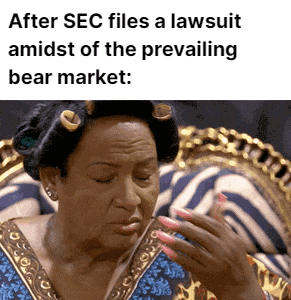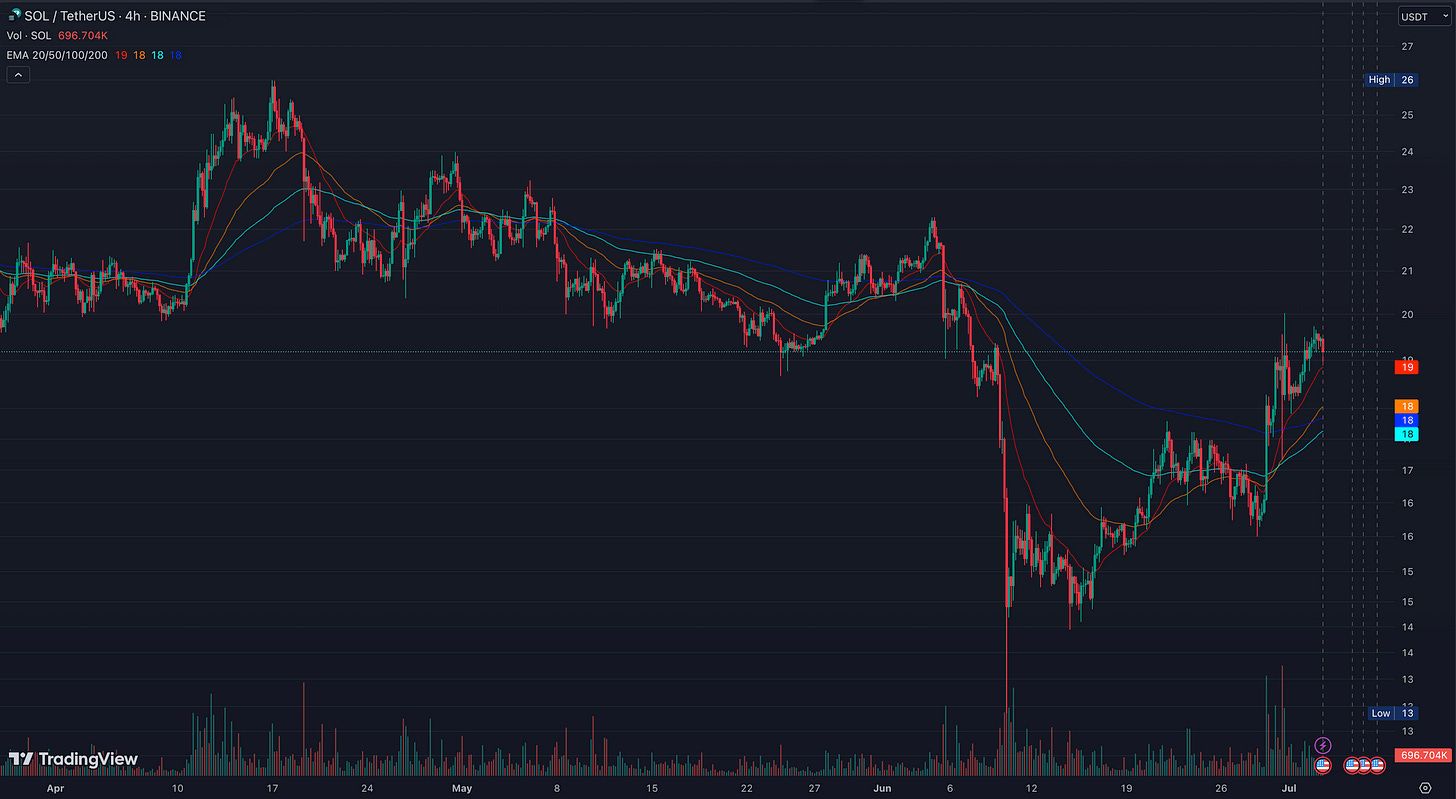Solana stands to be one of the fastest, most scalable, and most active crypto networks, promising the best– as an “Ethereum killer”. Despite its close association with FTX and Alameda in the past, it had significantly recovered from the value crash of 2022. In January 2023, Solana’s price was reported to surge 133%, raising hopes for the community. It surpassed Bitcoin and Ether, shrugging off the past reputational damage. But the market took an unexpected turn when the SEC filed a lawsuit against Binance and Coinbase, categorizing certain cryptocurrencies as securities. With Robinhood delisting Solana as a result of the lawsuit, the road ahead seems to be full of uncertainties for the stakeholders. Amidst of all the tension, A new horizon of hope appears before the crypto market as Ripple wins the lawsuit against SEC and, BlackRock, the asset management giant, filed an application to launch Bitcoin ETF that could potentially open a whole new dimension allowing institutional investors to invest in crypto.
Introduction to DeFi
DeFi has been around for as long as the blockchain technology. But the idea of integrating decentralized ledgers in Finance actually started booming around 2019. It started attracting consumers who envisioned eliminating the need for intermediaries like banks and brokers by enabling peer-to-peer transactions. As for Solana’s entry into the DeFi scene, it gained significant market capital in the year 2021.
Throughout the year 2021, Solana's native token, SOL, experienced a remarkable rally, reaching an all-time high of $260.06 in November. This surge in popularity established Solana as a prominent platform for DeFi applications and solutions.

Solana stepping in
Founded in 2017, Solana gained massive popularity in the market as an “Ethereum killer”. It initially surpassed the expectations of the market by the number of transactions it could process and the fees required to perform those transactions. Apart from that, the platform is insanely popular with Web3 developers. The cryptocurrency that runs on the Solana blockchain—also named Solana (SOL/USD) and using the ticker symbol SOL—experienced a price increase of almost 12,000% in 2021 and at one point had a market capitalization of over $66 billion, making it the fifth-largest cryptocurrency by this measure at the time.
Surviving the FTX Bankruptcy
Despite Solana’s commendable progression, the FTX Bankruptcy in 2022 hit the hardest for Solana. The dramatic price decline and challenges, faced by Solana, can be attributed to its close association with FTX and Sam Bankman-Fried (SBF).
The cryptocurrency exchange, FTX, had a significant investment in Solana and was involved in high-profile projects like the Serum exchange, a major DeFi platform on the Solana network. However, it experienced a collapse and became bankrupt, leading to concerns about the future of Solana's treasury, including its tokens and investments in FTX-related assets. The close ties between Solana and FTX created uncertainty, causing funds, users, and major projects to leave the platform. As a result, Solana's on-chain activity, trade volume, and DeFi liquidity declined significantly.
Notable developments include Tether removing $1 billion from Solana and major exchanges, like Binance, Crypto.com, and OKX, paused Solana-based deposits and withdrawals. Adding on to that, several major NFT projects have announced plans to migrate to other blockchain networks.
Despite the staggering fall of lending platforms and DeFi on Solana, the development activities were at their peak. This indicated that the developers saw more value in the underlying ecosystem that outweighed any slumps in user activities.

Getting it back?
After the sturdy drawbacks Solana had to face due to its entanglement with FTX, the reports at the beginning of this year seem to indicate an upswing for the DeFi platform. Its native currency, SOL, experienced a significant price recovery this year. After facing a record low, SOL had doubled its price since mid-December, reaching around $21 and even touching $24. By January, SOL exceeded Bitcoin and Ethereum by an astounding rise of 133%. The price surge was sparked by a positive tweet from Ethereum co-founder Vitalik Buterin, who expressed hope for the Solana community. In his words, the coin should get “its fair chance to thrive”.
Despite its past entanglement with the troubled crypto exchange FTX and its sister company Alameda Research, SOL had shown resilience. SOL's price recovery renewed hope among analysts and blockchain developers for the blockchain's long-term prospects. In the post-FTX period, Solana's on-chain performance had remained strong, with transaction volumes and active accounts having rebounded.
The upsurge in trading volume can be attributed to growing interest in the Solana-based meme coin BONK. According to the experts, SOL's price could have rebounded to $30 or even $50 by the end of the year, drawing parallels to Ethereum's recovery after the 2018 bear market.
The SEC lawsuit
Just when things started to turn better, last month the US market regulators pulled an aggressive stunt against the crypto market. They filed a lawsuit against Coinbase and Binance where certain cryptocurrencies were marked as “securities”-- Solana being one of them. Although the industry took no time in standing against the claims, the alleged tokens had to take some collateral damage. Solana’s Thursday Hacker house event in New York City assured that not much will change for the developers on the chain. Meanwhile, two streams of opinion emerged from Twitter regarding hard fork. Many consider this should be the only way out for Solana, since Robinhood has already delisted Solana. Besides, the possibility of Coinbase and Binance opting for the same cannot be crossed out. Another stream of Tweets harshly opposed the idea of hard fork, reasoning that it hardly brings any good unless they remove balances from certain accounts, i.e., FTX’s 8.2% holdings. While the whole Twitter community is brawling over a hard fork, one of the platform’s code auditors and cybersecurity researchers responded on the subject, revealing that no one from the development end is considering a hard fork at present. Unfortunately, the fate of the protocol is on hold since, Solana co-founder, Anatoly Yakovenko, is yet to announce anything.
To look on the bright side, SEC has just lost the lawsuit it filed against Ripple in December 2020. The year-long fight has ultimately resulted into a verdict in favour of crypto. This event has already started to improve the crypto market and Solana seems to be outperforming all the big names.

Overview of Q1 2023
A brief overview of what happened in the first Quarter of this year will be helpful to determine the accurate state of the ecosystem:
- Solana's market value increased by 118.1% during the last quarter as revenue generated by Solana (in SOL) rose by 68.7% during the same period, mainly due to more people using priority fees.
- Various developments in the Solana ecosystem contributed to increased transaction activity and fee payments in the first quarter. The notable ones were– the BONK airdrop, several collections of non-fungible tokens (NFTs), and DePIN applications.
- Platforms such as Marinade Finance, Lido, Jito, and JPool played a leading role in driving the growth of Liquid staking derivatives (LSDs).
- The Solana Foundation's growth initiatives to invest in its ecosystem continued, including Grizzlython, which became the largest hackathon in Solana’s history.
- The average number of validators increased by 18.9% QoQ, signaling that the network progressed toward a more decentralized state.
- Shortly after the release of the v1.14 upgrades on February 21, the Solana network experienced an outage due to Gulfstream issues and anomalous consensus bug. While network updates seem to have dealt with Gulfstream issues, Solana Labs has submitted a plan for recent anomalous network outages.

Conclusion
When compared to Ethereum, Solana demonstrates several advantages. Its scalability, faster transaction speeds, and lower fees make it an appealing alternative. Solana's NFT volume surpassing Ethereum indicates a shifting trend in NFT activity. Additionally, Solana's commitment to decentralization and the resilience of its ecosystem in the face of challenges like the FTX collapse and the bear market provides further validation for its potential as a formidable competitor to Ethereum. On top of that, Solana outperforming major crypto chains after Ripple's win against
Looking ahead, Solana's NFT and DeFi ecosystems are expected to continue their growth trajectory, fuelled by ongoing development efforts and increasing user adoption. If Solana can maintain its technological advancements and continue attracting developers and users, it has the potential to establish itself as a prominent player in the cryptocurrency and blockchain landscape, potentially challenging the dominance of Ethereum in certain areas.